This article is all about the relationship among classes. This is the fundamental in ‘Object Oriented Programming‘ design. In Object Oriented designing, the decision always boils down to “IS A” relationship or “HAS A” relationship. Thus, it is important to know “IS A” relationship or “HAS A” relationship in order to design any object . Code Re-use – This is one of the attribute of OOPs. This is attained either by Composition or Inheritance.
How to identify Inheritance? The easiest way to identify the candidate for inheritance is by asking yourself a quest ion – “Is this new candidate “is a” / kind /sub-type of an old candidate?.” If the answer is yes, then it is very much suitable for inherit ance. Now, the new candidate is the derived class, and the old candidate is the base class. In short , the inheritance depicts the relationship – “is a”. As you can identify, this is a uni-directional relationship. It means that the derived class is a type of base class. However, the base class is not a type of derived class. In summary, you can create a specialised form from a generic form. On the contrary, the generic form cannot be created from the specialized form. In OOps, the generic form can be an abstract class or an interface class. Later, we will see generalization and realization in inheritance.
Example – PVR Set top box is a type/kind of Settopbox(STB). Here, the STB is the base class, and the PVR STB is a derived class.
How to identify Composition? The easiest way to identify the candidate for composition is by asking yourself a question – “Is this new candidate has an old candidate?. If the answer is yes, then it is very much suitable for composition. Here, the new candidate “has a/an” old candidate. In short , the composition depicts relationship – “has a”. As you can identify, this is a uni-directional relationship. It means that the new candidate contains the old candidate. However, the old candidate doesn’t contain the new candidate.
Example – Settop box has a tuner. Here, the STB class contains another class object – tuner, as a member variable. Later, we will see the aggregation and composition. Also, aggregation is called a weak composition. On the other hand, composition is called a strong composition. Later, we will see why they are called so. Terms to describe relationship among classes These terms are not only useful in creating the logical diagrams i.e. class diagrams, but also they are useful from design aspects.
Association - This term is used to describe the relationship/dependency between classes.
General Association – This tells what other class/classes a class needs to perform a particular service. Based on the number of dependencies, the multiplicity is defined. The multiplicity can be one to one, one to many, many to one, and many to many.
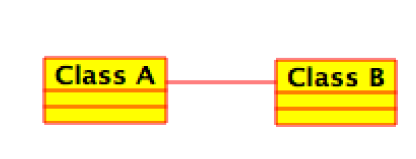
Directional Association – This association tells about what object is contained by the other object . Here, the direction is essential to express the relationship. For example, whether class A contains class B or class B contains class A.
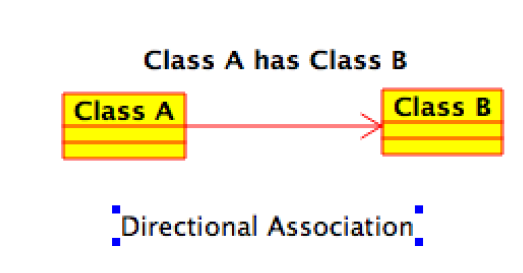
Types of Directional Association – “Has -a” Relationship
- Aggregation – Also, this is called a weak composition. Here, the object that is contained by the new object can exist independently. The life time of the contained object is not controlled by the container object . Generally, the contained object is passed to the constructor of the container object . There is an advantage of aggregation – the coupling between classes are not strong. The dependent objects are passed to the new object by the client . In my opinion, this is a neat design. Personally, I prefer aggregation over composition. Example- In a STB, HDD has a fan. Both HDD and fan can exist independently. Here, the coupling between them is not strong. Both the objects HDD and Fan can exist independently. If HDD is killed, then FAN can exist . In short , the Fan can keep spinning even when the HDD is dead. This example is just to show the concept of the aggregation in terms of the life time of contained and container object . While programming/designing composition, we just think in terms of loosely coupled or tightly coupled classes.
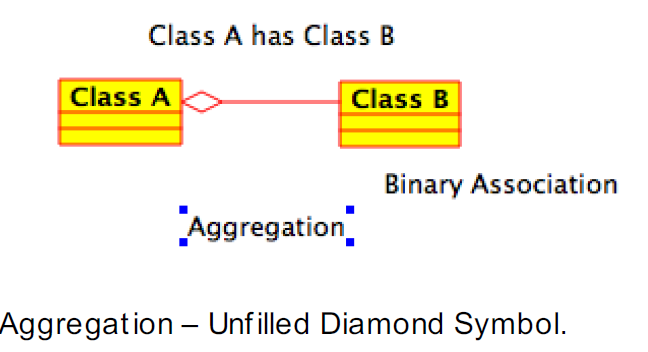
- Composition - Also, this is called a strong composition. Here, the object that is contained by the new object cannot exist independently. The life time of the contained object is controlled by the container object . Many people refer ‘composition’ as a special case of ‘aggregation’. Example- Front Panel has a LED. Here, the LED cannot exist without a Front Panel. If the Front Panel dies, the LED on the Front Panel dies. In such a case, the LED life time is associated with the life time of Front Panel. Here, the coupling between them is strong.
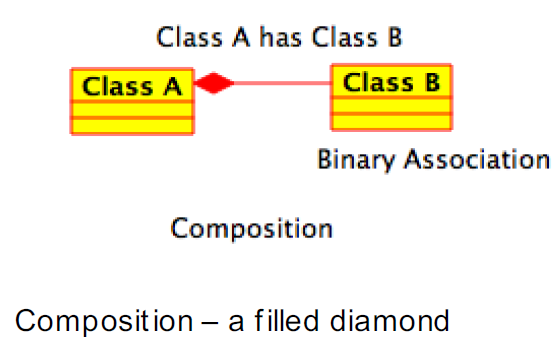
Inheritance - ” IS A” Relationship Before we dive into inheritance, let’s understand the two types of classes. a. Abstract class – This is a blue print – model of the object . However, it cannot be instantiated. An abstract class has a few general methods implemented. They generally have protected member variables that can be inherited by the sub-class/derived class. However, there are a set of methods, which are not implemented . It is expected that the derived class will extend the property of abstract class. Also, the derived class will implement the not implemented methods of the abstract class. In C++, we make the abstract class by putting the keyword ‘virtual’ and equating the method to zero. For example, the following is the syntax to make the class abstract in C++.
/* a pure virtual function * /
virtual void unImplementedMethod(void) = 0;b. Interface class – This is a blue print – model of the object. However, it cannot be instantiated. An interface class has only pure virtual methods i.e. properties that is expected by the class. A derived class will implement the interface class. Unlike abstract class, the interface class has no methods implemented. Also, it doesn’t have any member variables. A derived/subclass always implements the interface class. Generally, the name of interface class starts with the letter ‘I’.
How an ‘Inheritance’ is synthesized ?
- Generalization – Here the derived class extends the abstract class. Basically, the base class – Abstract class is a generalized class. Here, the derived class is a specialized class.
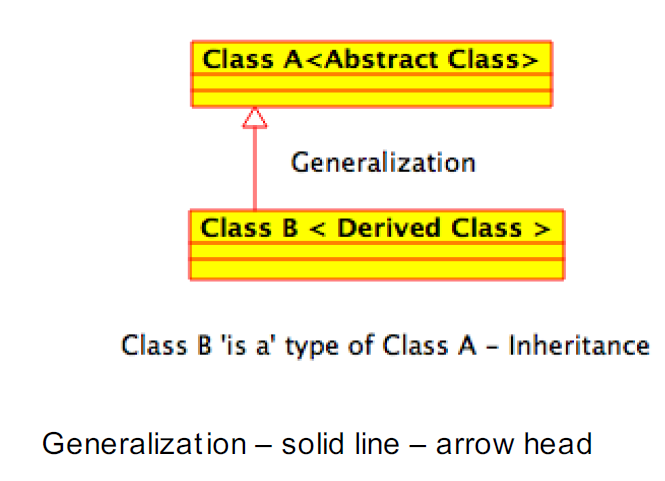
- Realization – Here the derived class implements the interface class.
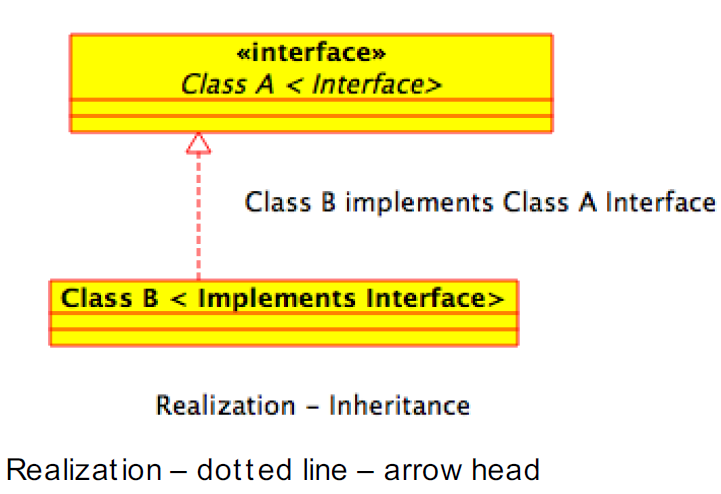
Another way to synthesize Composition is with the help of Private Inheritance:
This is another way to implement composition using private inheritance. So, generally people ask “what is the use-case of private inheritance”, and the answer is composition. Practically speaking, private inheritance is not preferred to do composition -at-least I didn’t see in the industry. Let’s see how private inheritance does the job of composition.
Property of Private inheritance -
- All the private members of the base class is not inherited.
- All the public members of the base class is inherited as private only.
- All the protected members of the base class is inherited as private only. Here is the Program to realize composition using Private Inheritance. After private inheritance, the derived class contains the base class according to the aforesaid three rules. Or in other words, the derived class has a base class. Here, the public methods of the derived class will call its private methods, which is a base class – protected and public members. If you have the getters and setters in the base class for the private members, then the derived class can indirectly access the private members of the base class using these getters and sett ers. The following example depicts this attribute.
#include <QtCore/QCoreApplication>
#include <QDebug>
class BaseClass
{
private:
QString baseClassName;
public:
void setBaseClassName(QString bName)
{
baseClassName = bName;
}
QString getbaseClassName()
{
return baseClassName;
}
virtual ~BaseClass()
{
}
};
class DerivedClass: private BaseClass
{
public:
void printtheBaseClassName()
{
qDebug()<<"The name of base Class is "<<getbaseClassName();
}
DerivedClass()
{
qDebug()<<"The Derived class object is Constructed";
}
void settheBaseClassNameFromDerived(QString DerivedName)
{
setBaseClassName(DerivedName);
}
};
int main(int argc, char * argv[])
{
QCoreApplication a(argc, argv);
DerivedClass * pDerived = new DerivedClass;
pDerived->settheBaseClassNameFromDerived("COMPOSITION from Inheritance");
pDerived->printtheBaseClassName();
delete pDerived;
return a.exec();
}Here is the output –
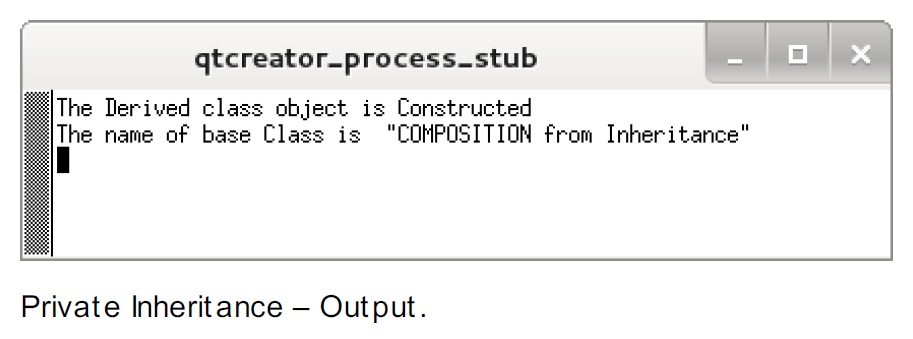
This tutorial covered alot of important Object Oriented Programming terminologies. It is important to know these terminologies in order to start designing your program – logical/class diagram.
